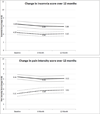Longitudinal course and impact of insomnia symptoms in adolescents with and without chronic pain
- PMID: 23031311
- PMCID: PMC3488154
- DOI: 10.1016/j.jpain.2012.08.003
Longitudinal course and impact of insomnia symptoms in adolescents with and without chronic pain
Abstract
This study aimed to 1) examine trajectories of insomnia symptoms in adolescents with chronic pain compared to their healthy peers; 2) evaluate psychological and behavioral risk factors for longitudinal insomnia symptoms; and 3) evaluate insomnia as a predictor of quality of life, activity limitations, and healthcare utilization over 12 months. Participants included 61 adolescents with chronic pain and 60 youths without chronic pain (12-18 years; 72% female). Questionnaires were completed at enrollment, 6 months, and 12 months and assessed pain intensity, insomnia symptoms, sleep hygiene, presleep arousal, depression, pubertal status, activity limitations, quality of life, and healthcare utilization. Insomnia symptoms persisted for both groups and remained higher at all time points for youths with chronic pain. Generalized estimating equations modeling identified 3 risk factors for longitudinal insomnia symptoms: having chronic pain, poorer sleep hygiene, and higher depressive symptoms. Insomnia symptoms also predicted poorer quality of life over time and were associated with more frequent healthcare utilization. Findings suggest that sleep problems are persistent and associated with negative impact for youths with chronic pain. Treatment of insomnia symptoms in youths with chronic pain may lead to improvements in quality of life and reductions in healthcare costs.
Perspective: Insomnia symptoms are persistent over a 12-month period and are associated with negative impact for youths with chronic pain. These findings suggest that treatment of insomnia symptoms in youths with chronic pain may lead to improvements in quality of life and reductions in healthcare costs.
Copyright © 2012 American Pain Society. Published by Elsevier Inc. All rights reserved.
Conflict of interest statement
The authors have no financial or other relationship that might lead to a conflict of interest.
Figures
Similar articles
-
Behavioral and psychosocial factors associated with insomnia in adolescents with chronic pain.Pain. 2011 Jan;152(1):89-94. doi: 10.1016/j.pain.2010.09.035. Epub 2010 Oct 27. Pain. 2011. PMID: 21030151 Free PMC article.
-
Association of insomnia severity with well-being, quality of life and health care costs: A cross-sectional study in older adults with chronic pain (PainS65+).Eur J Pain. 2018 Feb;22(2):414-425. doi: 10.1002/ejp.1130. Epub 2017 Oct 16. Eur J Pain. 2018. PMID: 29034538
-
A Single Arm Pilot Trial of Brief Cognitive Behavioral Therapy for Insomnia in Adolescents with Physical and Psychiatric Comorbidities.J Clin Sleep Med. 2017 Mar 15;13(3):401-410. doi: 10.5664/jcsm.6490. J Clin Sleep Med. 2017. PMID: 27923435 Free PMC article.
-
Psychological treatment for insomnia in the regulation of long-term hypnotic drug use.Health Technol Assess. 2004 Feb;8(8):iii-iv, 1-68. doi: 10.3310/hta8080. Health Technol Assess. 2004. PMID: 14960254 Review.
-
Painful Sleep: Insomnia in Patients with Chronic Pain Syndrome and its Consequences.Folia Med (Plovdiv). 2020 Dec 31;62(4):645-654. doi: 10.3897/folmed.62.e50705. Folia Med (Plovdiv). 2020. PMID: 33415907 Review.
Cited by
-
Personalized Multimodal Lifestyle Intervention as the Best-Evidenced Treatment for Chronic Pain: State-of-the-Art Clinical Perspective.J Clin Med. 2024 Jan 23;13(3):644. doi: 10.3390/jcm13030644. J Clin Med. 2024. PMID: 38337338 Free PMC article. Review.
-
Chronic Pain in Children and Adolescents: Diagnosis and Treatment of Primary Pain Disorders in Head, Abdomen, Muscles and Joints.Children (Basel). 2016 Dec 10;3(4):42. doi: 10.3390/children3040042. Children (Basel). 2016. PMID: 27973405 Free PMC article. Review.
-
Influence of chronotype on pain incidence during early adolescence.Pain. 2024 Nov 1;165(11):2595-2605. doi: 10.1097/j.pain.0000000000003271. Epub 2024 May 28. Pain. 2024. PMID: 38809249
-
Pain-related and Psychological Symptoms in Adolescents With Musculoskeletal and Sleep Problems.Clin J Pain. 2016 Mar;32(3):246-53. doi: 10.1097/AJP.0000000000000252. Clin J Pain. 2016. PMID: 25974623 Free PMC article.
-
Sleep outcomes in youth with chronic pain participating in a randomized controlled trial of online cognitive-behavioral therapy for pain management.Behav Sleep Med. 2015;13(2):107-23. doi: 10.1080/15402002.2013.845779. Epub 2014 Jan 31. Behav Sleep Med. 2015. PMID: 24484373 Free PMC article. Clinical Trial.
References
-
- Bastien CH, Vallieres A, Morin CM. Validation of the insomnia severity index as an outcome measure for insomnia research. Sleep Med. 2001;2:297–307. - PubMed
-
- Bloom BJ, Owens JA, McGuinn M, Nobile C, Schaeffer L, Alario AJ. Sleep and its relationship to pain, dysfunction, and disease activity in juvenile rheumatoid arthritis. J Rheumatol. 2002;29:169–173. - PubMed
-
- Bruni O, Fabrizi P, Ottaviano S, Cortesi F, Giannotti F, Guidetti V. Prevalence of sleep disorders in childhood and adolescence with headache: A case-control study. Cephalalgia. 1997;17:492–498. - PubMed
-
- Bruni O, Galli F, Guidetti V. Sleep hygiene and migraine in children and adolescents. Cephalalgia. 1999;19(Supp 25):57–59. - PubMed
-
- Butbul Aviel Y, Stremler R, Benseler SM, Cameron B, Laxer RM, Ota S, Schneider R, Spiegel L, Stinson JN, Tse SM, Feldman BM. Sleep and fatigue and the relationship to pain, disease activity and quality of life in juvenile idiopathic arthritis and juvenile dermatomyositis. Rheumatology (Oxford) 2011;50:2051–2060. - PubMed
Publication types
MeSH terms
Grants and funding
LinkOut - more resources
Full Text Sources
Medical


